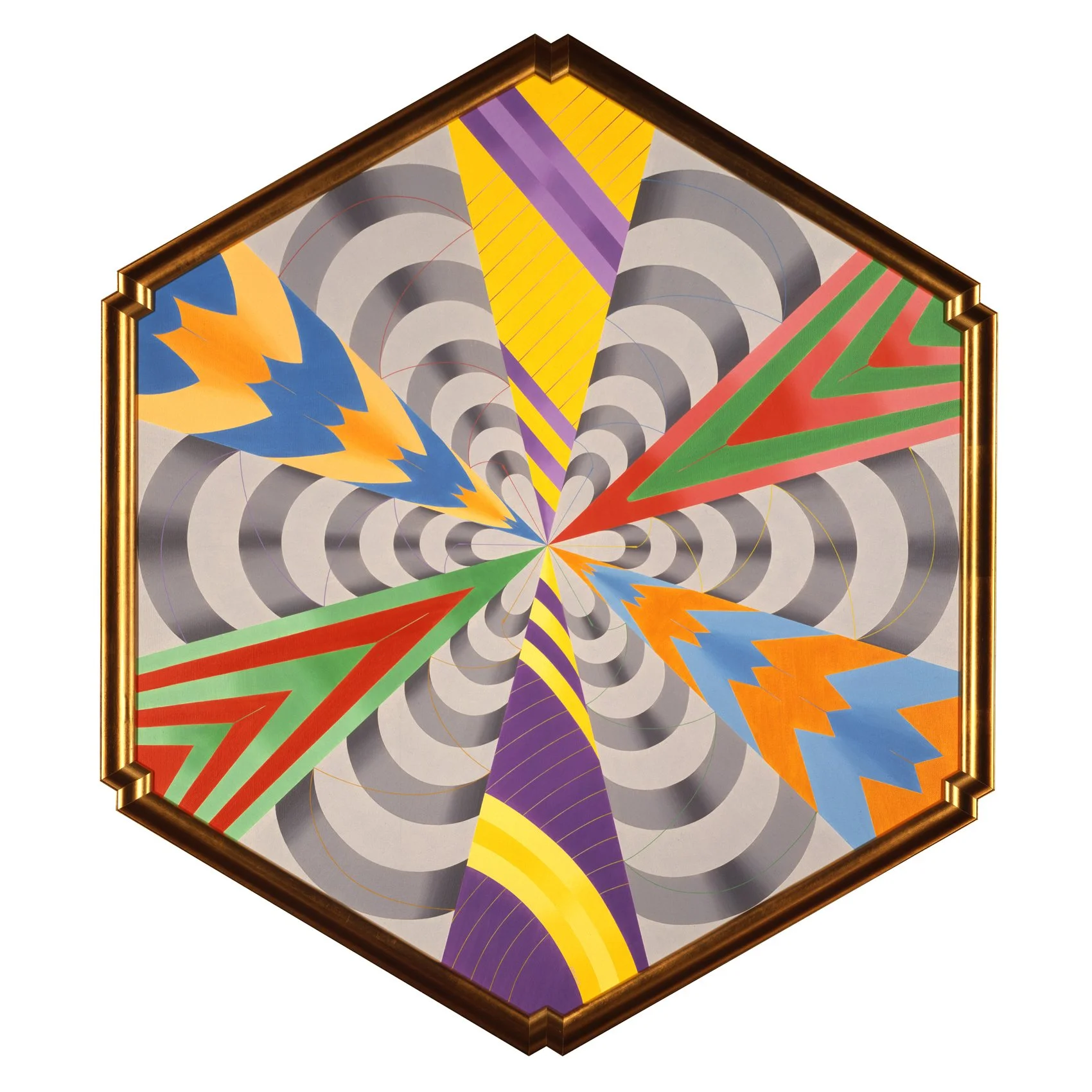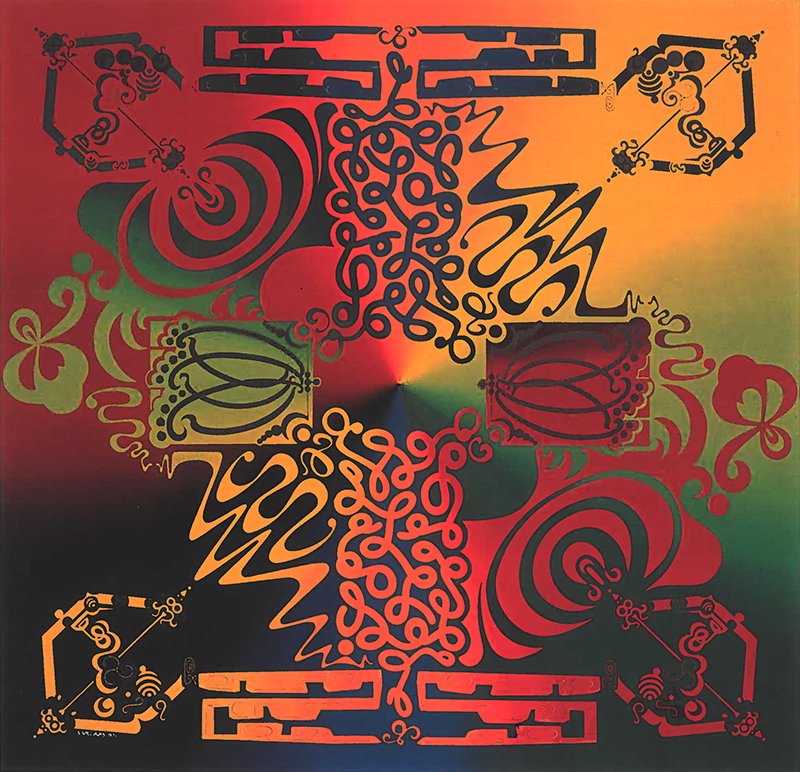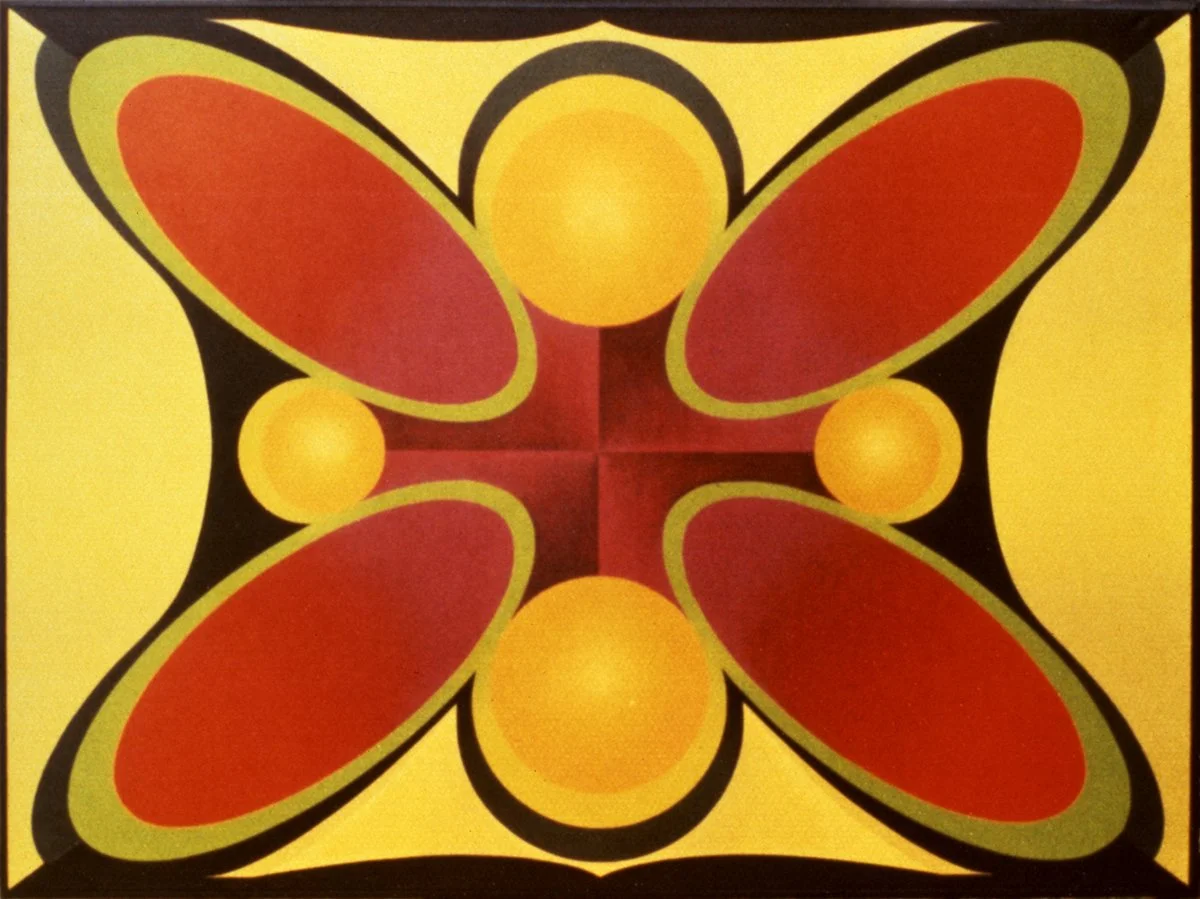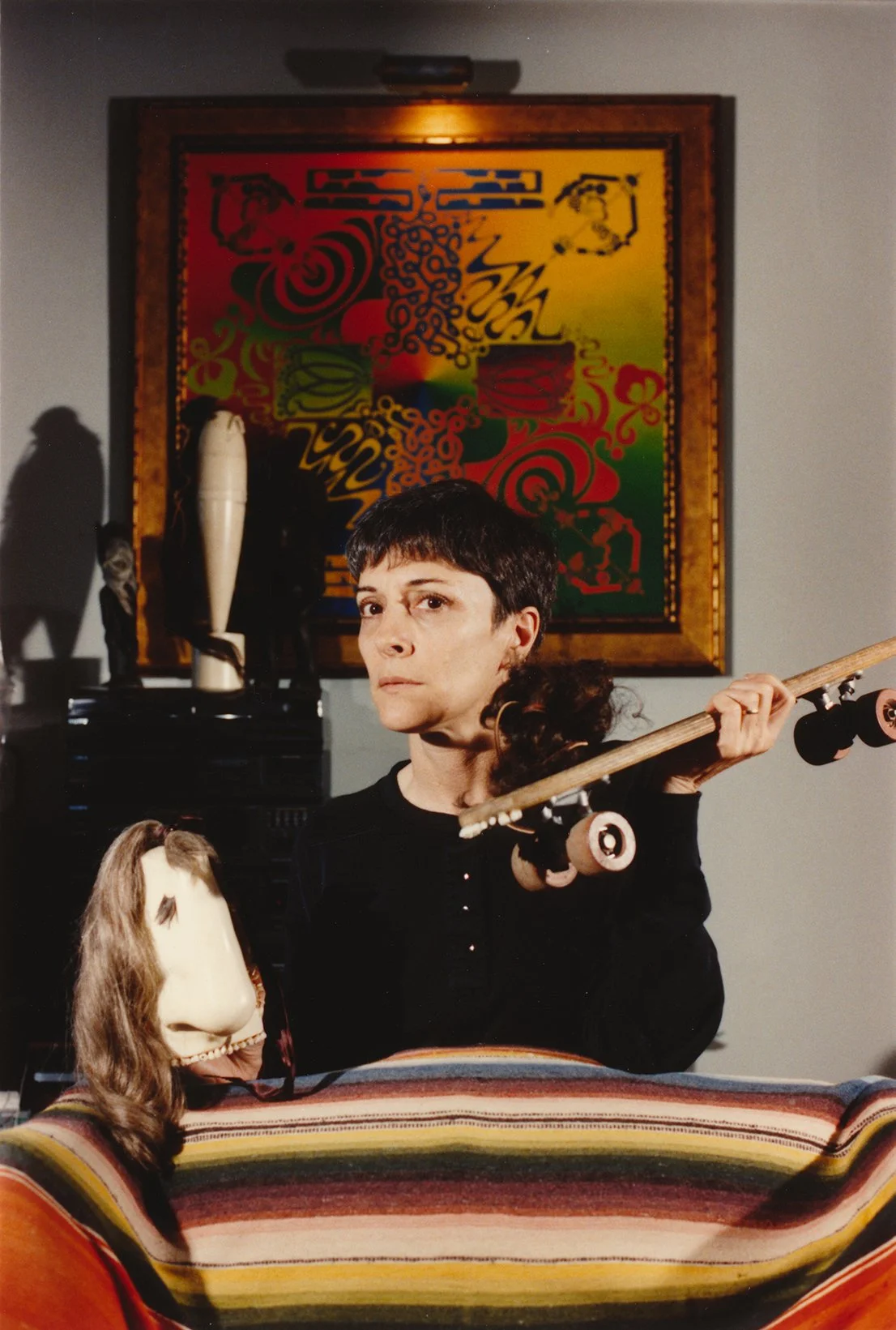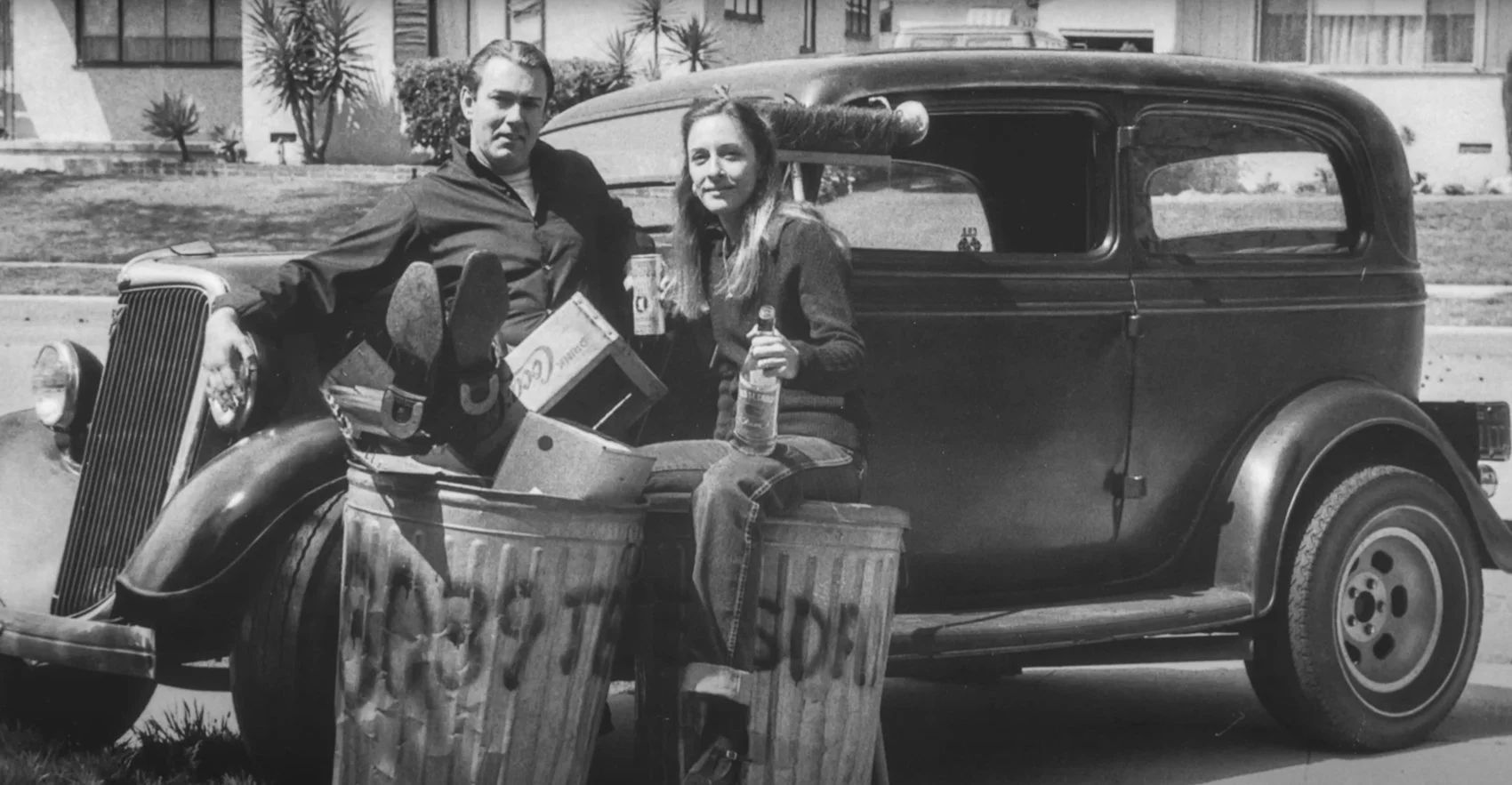Acute Diagonal Equilibrium
20" x 30", Oil On Canvas, 1991
VIEWING ROOM:
suzanne williams
CV
Press
Suzanne Williams High Art. High Times, June 1991
By Carlo McCormick
New York Press. Picks, December 1992
Catalog:
An Imprecise Survey of a Quest for Perfection: Selected Works by Suzanne Williams 1965-2000
Introduction by Michael McManus, with text by Mike McGee
California State University Fullerton Grand Central Art Center
February 1 – March 30, 2003
Photo by David Perry
Suzanne Williams (b. 1942, Los Angeles, CA) is an artist, oil painter, designer, cartoonist, hot-rodder and all-round Southern Californian legend.
Williams' life has been deeply entrenched in the California underground scene from the 1950’s to present day; packed with radical artists, thinkers and cartoonists such as R. Crumb, Ed Rucha, Timothy Leary and Ed “Big Daddy” Roth among many many others.
With a deep and eclectic background Suzanne combines her fine art aesthetic with her hand-made (non-digital) industrial and graphic design sensibilities. She brings the West Coast underground ethos into her practice creating highly detailed abstract works with a pop, roadster aesthetic.
Suzanne’s painting style is reflective of her deep love of hand-made perfection and foregrounds the finish-fetish movement indicative of Los Angeles artists for many years.
Suzanne Williams co-founded “Juxtapoz” in 1994 alongside her husband (artist) Robert Williams. The magazine helped define and celebrate underground and alternative artists, who in the ‘90’s were often shunned by the larger art-world. Now, many of these same artists are celebrated by that same larger art-world.
PAINTING
Suzanne’s paintings are simultaneously abstract and architectural imbuing them with a sensitivity to space with a mastery of hand-made precision. Never shy about experimenting with color and form to provoke the viewer’s eyes, Suzanne’s paintings are a phenomenological feast. The works also reflect notions of time, as one feels the artist’s steady hand, and in that steady hand the time spent reaching the level of mastery necessary to create the work
“Williams' works are beautiful, tough, articulate, exquisite, delicate, funny, dynamic, intricate, sizzling gems. These are jewels from the maker's hand… Their sense of scale is precise, refined, perfected. There is a felt sense of rightness about it, of mastery. Her compositions are rock solid, radiating tension and balance in all directions in complex equality.”
- Michael McManus
“ … I have no statement to make. I don’t want to say anything. I want my artwork to be completely visual. I want you to be able to look at it and like it or not like it. I’m a visual person and I do two-dimensional stuff because I see that way… To me art is not about changing the world… Visual stimulus is enough… ”
-Suzanne Williams
PROCESS and Drawings
















“ … The fundamental focus for Williams is the relationship between her eyes, hand and mind. Her process begins with a blue-lined white paged ledger book. She writes notes to herself. In some ways, her paintings are more akin to the calculations and concerns of mathematicians and physicists… than [the] aesthetic investigations traditionally engaged by artists. Her next step is to create sketches in pencil; first, just line work, then some initial color. Next she pressure traces the sketches onto carefully selected and primed linen canvases. Before she begins to paint, she erases the pencil line to eliminate any chance of the lead bleeding through the paint. She used to apply the paint in three coats, now she uses [only] one: no tape, just a steady hand to create those crisp edges. Each painting takes months to complete, a few have been a year in the making… ”
-Mike McGee
Photo by Aaron Kahan
Tooth fairy Gallery Series
“I thought it would be interesting to anoint inanimate objects with human attributes.
Did it change either of them?
Not really.
Inanimate remained inanimate and human remained human.
Although, it did allow for an interesting transformation into an object of art.”
-Suzanne Williams




education
“...Schooled in graphic arts and automotive design at Los Angeles City College (where she demanded permission to wear pants) and then Art Center College of Design, her natural aptitude at physics and algebra would have a profound influence on her mathematically precise paintings…”
-Lisa Fancher
“... I didn’t wear dresses because I got special approval to wear pants at LACC. I was the first girl to ever wear pants at LACC, and it just started opening up from there…
…I decided to go to Los Angeles City College because it had a really good art department…”
-Suzanne Williams
Photo by Aaron Kahan
“…Then I wanted to go to Art Center…
To me it was the most perfect school in the world because it was so technical. I entered the automotive design program, studying automotive for one year. I was the only girl.”
-Suzanne Williams
“...She had one goal: To learn skills. She didn’t want to use her imagination in the classroom…
…After she learned the appropriate rules and skills, she figured she could head home with enough knowledge to branch out into her own, twisting and molding those techniques into her own brand of art.”
-Sherri Cullison
IN STUDIO
“I think slowly, and I like what I like. I take a long time to select what I like and I put a lot into it. You can see I have infinite patience in my paintings.”
-Suzanne Williams
“…there's smoldering beneath the surface, a slow steady burn: the desire to know what two colors side-by-side and other combinations of visual elements look like, the desire to create quality that will sustain beyond the immediate, the desire to manufacture a pure experience, the desire to touch perfection…
Perfection is, of course, temporal; at best it is a state of mind that can only be sustained for intervals that are all too brief. …[if it is] ever truly obtained in pure form is arguable. Williams' paintings are documentations of a quest for this elusive state…For her, the pursuit of pure visual experience is a personal journey. As she put it, ‘I paint because I am obsessed with these ideas, and I need to know what they will look like on the canvas’…











“If you view Williams' paintings as a group it becomes increasingly obvious that specific references bounce from source to source never resting on one point long enough to be definitive. And each painting has a presence so strong that it renders such references negligible: like background music at a ceremony.
They may be two-dimensional but these paintings function as objects ... or, more accurately, fetishes.
They are the result of irrational obsession pursued with a passion historically reserved for sacred and transcendental endeavors. What gives these paintings such dynamic visual punch is the relentlessly confronting fact that they are the product of a level of focus and attention to detail that has been valued throughout time and is particularly rare in our culture today.
- Mike McGee
Photo from the Collection of Suzanne Williams
The confluence of cars & art











“…I designed the headliner pattern the same way I designed my painting with the lightning bolts coming to the center…”
-Suzanne Williams
“…those shapes converging to a central point unavoidably engage the hypnotic pull of a mandala; that blue triangle with its flat local color looks like it could have been plucked from a Hopi ritual sand painting; and those squiggly forms, with color contrasts so strong that the shapes vibrate, take you back to '60s psychedelics…those shapes converging to a central point unavoidably engage the hypnotic pull of a mandala; that blue triangle with its flat local color looks like it could have been plucked from a Hopi ritual sand painting; and those squiggly forms, with color contrasts so strong that the shapes vibrate, take you back to '60s psychedelics… As you look at the paintings individually, other references come to mind: the flames may have been appropriated from a souped-up muscle car… When you consider Williams' often flowing geometric shapes and complementary color schemes it is easy to make a connection to vintage '60s psychedelic rock posters. She personally knew Rick Griffin, Victor Moscoso, Stanley Mouse and other notable poster designers of the era. A rich blend of life experiences informs her paintings. Coming of age in the '60s … Williams was steeped in the mix of counter culture creativity…”
-Mike McGee
Suzanne Williams’ 1934 Chopped Sedan video
Video by 4 Speed Films, Ben Kahan and Aaron Kahan
Hot-Rod History
“The ’34 is my dream car…I made it visually exactly how I want. It’s the only car that I’ve ever had that I could do exactly how I wanted it. We got that car in ’73 and didn’t chop it until ’88… It’s got the perfect chop. It had to be 4 inches because 4 inches looks really radical, but any more than that loses all reasonable visual proportions. Beyond 4 inches you really can’t see out of it … Even more importantly, it looks cool. It has the most beautiful lines because of that. The back window of the car is leaned forward just a little. It’s so subtle you almost wouldn’t notice, but it made all the difference in the world… Ever since I can remember hot rodding… I always liked 34 Tudor sedans with chopped tops, they just looked so incredible. Mine’s just the perfect one. It’s got the perfect chop, it’s got everything I like. I think the only thing I might like to do someday is put a chrome windshield frame in it…”
-Suzanne Williams
“When you grow up in LA in the ‘50s, it’s hard to avoid the car thing because it was pretty pervasive … the kid across the street was always building Model A’s and Deuces. We’d get to help and go on the first rides when the seats were just milk crates…
…I got my ’57 T-Bird in 1969 because I needed a car. I was working on it myself … It was almost impossible to find parts then. You’d have to do the wrecking yard thing, and everyone was trying to screw you because you were a girl.”
Working with









“I was there in ’67 and ’68 I think. Actually you get pretty spoiled working for Roth. Because the place was just amazing to work in. He wasn’t a hard ass, but you had to get done what you had to get done… I used to draw the decals. Roth would have these wacky ideas, like ‘Do the Colt .45 label in a decal’. Weird stuff…
…I phased into working on Choppers magazine when he started it. I did a lot of the headlines, and I dropped out ugly backgrounds in shots of motorcycles. I also did the covers…
…[But] my name was not on the masthead of that magazine because of this “thing” I had. I was so intent on making it on my own. I had already changed my name to Bob’s name [Williams] because we were married. [And] Bob’s name was on the masthead of Choppers, so I decided to not have my name on it with his. That was probably one of the stupidest decisions I ever made …It’s one of the regrets I really have because I worked on it from day one.
…there was so much activity going on! Everybody knows that Tom Wolfe came there all the time, and the story about the IRS guy who had a desk there for a year. But there was the Hell’s Angels, lots of artists, over and underground. To say nothing of all the car guys that would come through there.
…It was really hard to think of going somewhere else for a job after that. So I didn’t really try. I started freelancing out of the house. I started doing mind-altering drugs (and I think you can see the influence in my paintings). Although I was more of a beatnik, I did fit into the bohemian art scene.
…Those were the thinking people then, they were broad-minded. It wasn’t so much the party scene, though … it was like a menagerie…”
-Suzanne Williams
Death
13" x 11", Cut Gouache Paper on Illustration Board, 1965
***temp location
HotRod Deluxe: Suzanne Williams Interview
Vicious, Delicious, and Ambitious
20th Century Women Artists
BOOK by Sherri Cullison


